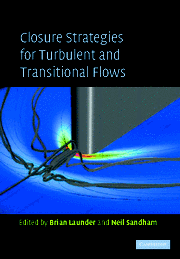11 - Modelling of Separating and Impinging Flows
Published online by Cambridge University Press: 06 July 2010
Summary
Introduction
Flows involving separation, reattachment and impingement occur widely in many diverse engineering applications. A number of cooling and drying processes rely on the high heat transfer rates that can be obtained by impinging fluid onto a solid surface. Separation and reattachment are, of course, found in numerous situations, including external aerodynamics, flow over obstacles and internal flow through ducts and pipes with rapidly varying cross-section or flow direction. Many of these internal flows are also associated with heat transfer, such as internal cooling passages for gas-turbine blades.
Since heat transfer rates are predominantly determined by the flow behaviour in the immediate vicinity of the wall, it is often necessary to employ low-Reynolds-number turbulence models, which can adequately resolve the near-wall region, when computing applications involving wall heating or cooling. However, the turbulence mechanisms near reattachment or impingement zones are significantly different from those found in simple shear flows where most turbulence models have been developed. In particular, as will be seen, the popular ϵ based models are often found to predict extremely large lengthscales in such flows, leading to the prediction of excessive heat transfer rates and the necessity of including additional modelling terms to correct for the defect. Furthermore, the irrotational straining found in impinging flows exposes a number of weaknesses in both eddy-viscosity based models and in widely-used stress transport closures.
As an example of the problems encountered in computing impinging flows, Figure 1 shows the predicted and measured Nusselt number, plotted against radial distance from the stagnation point, in an axisymmetric impinging jet flow studied experimentally by Baughn and Shimizu (1989) and Cooper et al. (1992). The jet issues from a long length of pipe, at a Reynolds number of 23000, and impinges perpendicularly onto a flat plate at a distance of 2 jet diameters from the pipe exit. The flow has been computed using a zonal modelling approach, with a high-Reynolds-number stress transport scheme in the fully turbulent region, and the Launder–Sharma k-ϵ model in the near-wall viscosity-affected region. Without additional modifications, it can be seen that, whilst the predictions are in agreement with the data at large radial distances (where the flow becomes a radial wall jet), the model fails, fairly spectacularly, in the stagnation zone, overpredicting the Nusselt number by a factor of four or more.
The following sections consider the problems encountered in the modelling of impinging and reattaching flows, including a discussion of some of the different solutions proposed, and example applications.
- Type
- Chapter
- Information
- Closure Strategies for Turbulent and Transitional Flows , pp. 341 - 360Publisher: Cambridge University PressPrint publication year: 2002



